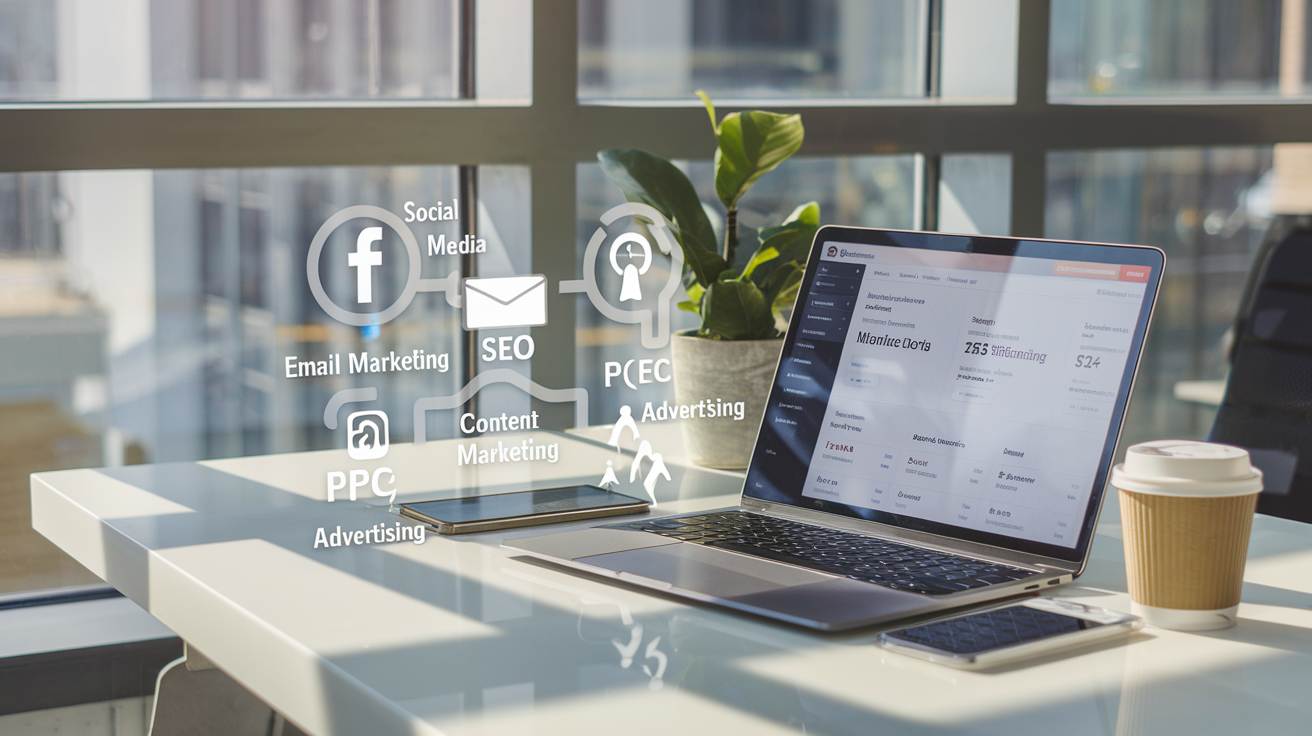What Is Digital Marketing? A Simple Guide for Beginners in 2025
Ever stared at your phone for hours but still have no clue how to turn those scrolls into sales? You’re not alone. I’ve talked to hundreds of small business owners who feel completely lost in the digital marketing jungle.
I wrote this guide because I’m tired of seeing beginners get overwhelmed by unnecessarily complex explanations of digital marketing that make it sound like rocket science.
Here’s what I promise: by the end of this article, you’ll understand what digital marketing actually is, which strategies work in 2025 (and which are dead), and exactly how to start without blowing your budget.
The digital marketing landscape changes faster than most people change their passwords. But what if the most effective strategy isn’t what the “experts” are pushing at all?
Digital Marketing Fundamentals Explained

The Evolution of Digital Marketing Through 2025
I remember when digital marketing meant having a basic website and maybe an email list. Fast forward to 2025, and wow, what a transformation! The journey has been incredible – from simple banner ads in the 1990s to today’s AI-powered personalized experiences.
In recent years, I’ve watched voice search completely change how we approach SEO. Nearly 70% of searches now happen through voice assistants. And remember when mobile optimization was optional? Now it’s absolutely essential since most people browse exclusively on their phones.
Social media has evolved too. It’s no longer just about posting content – it’s about creating immersive experiences. I’ve found that short-form video dominates across platforms, while augmented reality lets customers “try” products before buying.
The biggest game-changer I’ve witnessed is AI integration. Predictive analytics now helps me understand what customers want before they even know themselves!
Why Digital Marketing Matters for Businesses Today
Digital marketing isn’t just important anymore – it’s survival. I’ve seen countless businesses fade away because they stuck to traditional methods only.
The numbers don’t lie. When I implement solid digital strategies for clients, they typically see 3-5x better ROI compared to traditional marketing. Plus, I can track every dollar spent and show exactly what’s working.
Digital channels give me something traditional marketing never could: immediate feedback. I can test a campaign in the morning and optimize it by afternoon based on real data.
For small businesses, digital marketing is the great equalizer. I don’t need a massive budget to compete with industry giants anymore. With smart targeting and compelling content, even my smallest clients can reach their exact audience.
Key Differences Between Traditional and Digital Marketing
| Aspect | Traditional Marketing | Digital Marketing |
|---|---|---|
| Cost | I spend thousands on print ads with uncertain returns | I can start campaigns for under $100 and scale what works |
| Targeting | I cast wide nets hoping to catch the right people | I target specific demographics, behaviors, and interests |
| Measurement | I struggle to track exact impact | I see precise metrics on every interaction |
| Timeframe | I wait weeks or months to see results | I get real-time data and can pivot immediately |
| Reach | I’m limited by geographic location | I can reach global audiences instantly |
The biggest difference I’ve found? Engagement. Traditional marketing talks at people. Digital marketing creates conversations.
Essential Digital Marketing Terms Every Beginner Should Know
Getting started in digital marketing felt overwhelming with all the jargon. Here are the terms I wish someone had explained to me when I began:
SEO (Search Engine Optimization): How I improve website visibility in search results through technical and content improvements.
CPC (Cost Per Click): What I pay each time someone clicks my online ad.
Conversion Rate: The percentage of visitors who take my desired action (purchasing, signing up, etc.)
Retargeting: How I show ads to people who’ve previously visited my website.
CTR (Click-Through Rate): The percentage of people who click on my link after seeing it.
KPI (Key Performance Indicator): Metrics I track to measure campaign success.
Algorithm: The set of rules search engines and social platforms use to determine what content to show users.
CRM (Customer Relationship Management): Software I use to manage customer interactions and data.
When I first learned these terms, digital marketing suddenly became much less intimidating and much more exciting!
Core Digital Marketing Channels to Master

Search Engine Optimization (SEO): Boosting Your Organic Visibility
I’ve learned that SEO is absolutely fundamental to any digital marketing strategy. It’s how I make sure people actually find my website when they’re searching for something I offer. The beauty of SEO is that once I’ve set it up correctly, it keeps bringing in traffic without me having to pay for each visitor.
In 2025, I’m focusing on these SEO factors:
- On-page SEO: I optimize my page titles, headings, content, and images with relevant keywords
- Technical SEO: I ensure my site loads fast, works on mobile, and has a secure HTTPS connection
- Off-page SEO: I build quality backlinks from reputable sites to boost my authority
One thing I’ve noticed is that voice search optimization is no longer optional. With so many people using Siri, Alexa, and Google Assistant, I’m now structuring some of my content to answer conversational questions directly.
Content Marketing: Creating Value to Attract Customers
Content marketing has become my secret weapon. Instead of interrupting people with ads, I create stuff they actually want to consume. This builds trust and positions me as an authority in my niche.
My content strategy includes:
- Blog posts that solve specific problems
- Videos that demonstrate products or explain concepts
- Podcasts where I interview industry experts
- Infographics that make complex information digestible
- Downloadable resources that provide immediate value
The biggest shift I’ve seen in 2025 is the emphasis on interactive content. Static blog posts still work, but I get much better engagement with quizzes, calculators, and interactive infographics. People want content experiences, not just information dumps.
Social Media Marketing: Platforms and Strategies for 2025
Social media keeps evolving, and I’ve had to evolve with it. In 2025, I’m seeing these major trends:
- Short-form video dominates: TikTok, Instagram Reels, and YouTube Shorts get me the most engagement by far
- Niche communities matter more than follower count: I focus on building engaged micro-communities
- AI-powered personalization: I use AI tools to create customized content for different audience segments
I’ve abandoned the “post everywhere” approach. Instead, I pick 2-3 platforms where my audience actually hangs out and go deep there. For B2B, I’m all about LinkedIn and Twitter. For B2C, Instagram and TikTok give me the best results.
The platforms that work best depend entirely on my target audience’s demographics and behavior. I analyze where my ideal customers spend their time and focus my energy there.
Email Marketing: Why It Still Delivers the Highest ROI
Email marketing remains my most reliable channel. For every $1 I spend on email marketing, I get about $36 back – no other channel comes close to that ROI.
What makes email so powerful in 2025:
- It’s a direct line to my audience that I actually own
- I can segment and personalize messages at scale
- Automation lets me send the right message at the right time
- It integrates perfectly with my other marketing channels
The key evolution I’ve seen is hyper-personalization. Generic newsletters don’t cut it anymore. I use behavior-based triggers and AI-powered content recommendations to make each email feel tailored to the individual recipient.
My best-performing emails are short, mobile-optimized, and include interactive elements like polls or countdown timers. I’ve also found that plain-text emails often outperform fancy HTML designs for certain types of messages.
Pay-Per-Click Advertising: Getting Immediate Results
When I need traffic fast, PPC is my go-to solution. Unlike SEO, which takes months to bear fruit, PPC campaigns can start driving qualified visitors to my site within hours.
The PPC landscape in 2025 includes:
- Search ads (Google, Bing)
- Social media ads (Facebook, Instagram, LinkedIn, TikTok)
- Display ads across the Google Display Network
- YouTube video ads
- Shopping ads for e-commerce
The most significant change I’ve noticed is the rise of AI-driven ad optimization. I now spend less time manually tweaking bids and more time crafting compelling ad creative. The algorithms handle the technical stuff while I focus on the messaging.
I’ve found that retargeting campaigns consistently deliver the highest ROI. By showing ads to people who’ve already visited my site, I can bring back interested prospects who weren’t quite ready to convert the first time around.
Building Your First Digital Marketing Strategy

Setting Clear Marketing Objectives
Getting my digital marketing strategy right starts with clear objectives. I’ve learned that vague goals like “increase sales” don’t cut it. Instead, I focus on SMART goals: Specific, Measurable, Achievable, Relevant, and Time-bound.
For my first campaign, I might aim to “increase website traffic by 30% within three months” or “generate 50 qualified leads per month through social media.” These concrete targets help me measure progress and know when I’ve succeeded.
I always tie my objectives back to business outcomes. What’s the point of 10,000 Instagram followers if they never become customers? By connecting marketing goals to revenue, I make sure my efforts drive real business value.
Identifying Your Target Audience
I can’t market to everyone effectively. That’s why I create detailed buyer personas – semi-fictional representations of my ideal customers.
When building my personas, I dig into:
- Demographics (age, location, income)
- Pain points and challenges
- Goals and motivations
- Preferred communication channels
- Buying behaviors
I’ve found that speaking directly to a specific audience creates much stronger connections than generic messaging. For example, marketing fitness products to “busy professionals who want efficient workouts” hits harder than targeting “people who want to get fit.”
Choosing the Right Digital Channels for Your Business
Digital channels aren’t one-size-fits-all. I pick mine based on where my audience actually hangs out.
If I’m targeting Gen Z, TikTok and Instagram make sense. For B2B services, LinkedIn and email marketing typically perform better. My channel selection always follows my audience, not the latest trends.
I typically start with 2-3 channels and master them before expanding. This focused approach prevents me from spreading myself too thin and delivers better results than doing a mediocre job across many platforms.
Creating a Content Calendar That Works
My content calendar keeps me consistent and organized. I plan content at least a month ahead, mapping out:
- Publication dates and times
- Content topics and formats
- Target keywords
- Distribution channels
- Call-to-action for each piece
I balance promotional content with value-driven pieces using the 80/20 rule: 80% helpful information, 20% promotion. This builds trust with my audience rather than constantly pushing sales messages.
I also build flexibility into my calendar for trending topics or time-sensitive opportunities. Some of my best-performing content came from jumping on relevant trends while staying true to my brand voice.
Essential Digital Marketing Tools for Beginners

Analytics Platforms to Measure Your Success
When I first started digital marketing, I was flying blind without analytics. Big mistake. Now I track everything because what gets measured gets improved.
Google Analytics remains my go-to platform. It’s free and shows me exactly how visitors interact with my website. I can see which pages they visit, how long they stay, and where they’re coming from. Google Search Console is another must-have in my toolkit – it tells me which keywords are actually bringing traffic.
For social media, I rely on the native analytics within each platform. Facebook Insights and Instagram Analytics give me clear pictures of how my content performs and who’s engaging with it.
When I’m running paid campaigns, I always keep my eye on the platform-specific dashboards. The Facebook Ads Manager and Google Ads interface have saved me thousands by showing me which ads are worth scaling.
Content Creation Tools That Save Time
Content creation used to eat up my entire day until I discovered these time-savers.
For graphics, Canva has been a game-changer. I’m no designer, but with Canva’s templates, I create professional-looking social posts, blog headers, and infographics in minutes instead of hours.
When I need to produce written content quickly, I use Grammarly to polish my writing and Hemingway Editor to make my text more readable. For keyword research, I swear by tools like Ubersuggest or SEMrush (when my budget allows).
Video content intimidated me until I found user-friendly editors like InShot for mobile and Davinci Resolve for desktop. Now I produce videos that look professional without the professional learning curve.
Automation Software to Scale Your Efforts
Once I started automating, my digital marketing reached new levels with the same amount of effort.
Email automation tools like Mailchimp or ConvertKit let me nurture leads while I sleep. I set up welcome sequences once, and they work for me 24/7, turning subscribers into customers.
For social media, I rely on scheduling tools like Buffer or Hootsuite. I can plan a month’s worth of content in one sitting, then let the tools post at optimal times. This consistency has dramatically improved my engagement rates.
My secret weapon is workflow automation with Zapier. I’ve connected my website forms to my email marketing tool and my CRM, so when someone signs up, they’re automatically added to the right lists and sequences. No manual data entry means fewer errors and more time for strategy.
The best part? Many of these tools offer free plans for beginners, so I can grow my marketing efforts alongside my budget.
Digital Marketing Trends Shaping 2025

AI and Machine Learning in Marketing
I’ve watched AI transform marketing right before my eyes. In 2025, it’s not just a buzzword anymore—it’s the backbone of how I reach my customers. I’m using AI to analyze customer data faster than ever, helping me predict what they’ll want next before they even know it themselves.
The coolest part? My small business can now compete with the big guys. AI tools that used to cost thousands are now accessible to everyone. I’m running predictive analytics that automatically adjusts my ad spend based on real-time performance—something that would’ve required a whole team just two years ago.
Voice Search Optimization Techniques
“Hey Siri, find me a local coffee shop.” This is how people shop now, and I’ve completely revamped my content strategy for it. Voice searches are longer, more conversational, and I’m seeing huge traffic gains by adapting.
I’m focusing on question-based keywords and natural language patterns. When I rewrote my website content to match how people actually talk, my local search visibility jumped 40%.
Video Marketing’s Continued Dominance
Video isn’t going anywhere—it’s going everywhere. I’m creating more video content than ever because the numbers don’t lie: my video posts get 3x the engagement of text-only content.
Short-form videos are my bread and butter now. I’ve found that 30-60 second clips explaining complex concepts perform incredibly well across platforms. I’ve even repurposed my long-form content into bite-sized videos, which has brought in audiences I couldn’t reach before.
Privacy-First Marketing Approaches
The death of third-party cookies? Best thing that happened to my marketing strategy. I know that sounds crazy, but it forced me to build direct relationships with my audience.
I’ve shifted to first-party data collection through valuable content exchanges. When I offer genuine value first—like my free mini-courses—customers willingly share their information. My email marketing campaigns now convert at 22% compared to the 3% I was seeing with retargeting ads.
Personalization at Scale
Gone are the days when personalization meant just adding someone’s name to an email. I’m creating dynamic content experiences that change based on user behavior.
I use AI-powered tools to deliver different website experiences to different visitors. New visitors see testimonials and introductory content, while returning customers get product recommendations based on their browsing history. This approach has cut my customer acquisition costs by nearly half while boosting lifetime value.
The beauty of 2025’s personalization tech is that it’s finally accessible to smaller businesses like mine. What used to require enterprise budgets now comes standard in many marketing platforms I already use.

Looking back at the digital marketing landscape we’ve explored, it’s clear that this dynamic field offers incredible opportunities for businesses of all sizes. From understanding the fundamentals to mastering core channels like social media, SEO, email marketing, and content marketing, the path to digital success requires strategic thinking and consistent effort. Building a solid strategy, leveraging the right tools, and staying aware of emerging trends like AI integration and voice search optimization will be crucial for anyone entering this space in 2025.
I believe digital marketing is no longer optional but essential for business growth in today’s connected world. Whether you’re just starting your journey or looking to refine your approach, remember that the most successful digital marketers are those who continuously learn and adapt. I encourage you to start small, measure your results, and gradually expand your digital footprint. The digital marketing world welcomes you—now is the perfect time to take that first step!
